June 23, 2006
Air Date: June 23, 2006
FULL SHOW
SEGMENTS
A Supreme Look at the Swamp
/ Jeff YoungView the page for this story
The US Supreme Court is split on whether the Clean Water Act protects all wetlands. Living On Earth's Jeff Young tells us what's next for wetlands protection and what the decision tells us about the court's newest members. (07:00)
A Green Legacy?
View the page for this story
The Bush Administration has officially limited the use of snowmobiles in national parks and has created a massive marine protected area as a national monument off the Hawaiian coast. Are these signals of a new environmental direction for the administration? Host Steve Curwood talks with Terry Anderson, executive director of the Property and Environmental Research Center in Bozeman, Montana. ()
Fishy Business
View the page for this story
Fish stocks crashed in the U.S. in the late 80’s, prompting the government to require rebuilding plans for all overfished species. Host Steve Curwood turns to Professor Andy Rosenberg, of the University of New Hampshire, who has just completed a ten-year assessment of fish population rebuilding efforts in the U.S., to find out how the recovery’s going. (05:00)
Cultural Connection
/ Durrell DawsonView the page for this story
Over a relatively short time, understanding the Earth's climate history has become one of the most happening areas of scientific research. In New Zealand, climate researchers are trying to glean climate knowledge from the country's original inhabitants, the Maori. Durrell Dawson reports some of these researchers are Maori themselves, and that gives their work a certain poignance. (09:00)
Greening Your Grass the Eco Way
View the page for this story
Living on Earth's Steve Curwood speaks with Urvashi Rangan - editor of greenerchoices.org, a service of consumer reports - about earth-friendly lawn care, pesticides, and natural ways to keep pests off the backyard. (04:30)
The U.S. Interstate System Turns 50
View the page for this story
It’s the 50th Anniversary of the U.S. Interstate System, and Living on Earth takes a ride in a 1951 Hudson along I-95 in Boston. Our chauffeur: Dan McNichol, author of “The Roads that Built America: The Incredible Story of the U.S. Interstate System.” Along the way we meet a livery driver who remembers the days before the Interstate, and a trucker who makes a pit-stop on his regular cross-country run. (16:00)
Show Credits and Funders
Show Transcript
HOST: Steve Curwood
GUESTS: Terry Anderson, Dan McNichol, Urvashi Rangan, Andy Rosenberg
REPORTERS: Jeff Young, Durrell Dawson
[THEME MUSIC]
CURWOOD: From NPR, this is Living on Earth.
[THEME MUSIC]
CURWOOD: I’m Steve Curwood. George Bush gives his presidential seal of approval, creating the largest marine sanctuary in the world. And he reverses course: Now the president wants to keep snowmobiles out of the National Parks, and it’s not playing well to his political base.
ANDERSON: It is not going to leave the president with some great legacy as a conservation or environmental president, that ain’t gonna happen no matter what.
CURWOOD: Also, a trip down memory lane…the interstate highway system turns 50. It’s quite a ride. Fast and safe. Buckle up!
MCNICHOL: The interstate system is by far the safest highway anywhere in the world by a factor of two. If your family is going across the country, you’re twice as likely to live if you take the Interstate system.
CURWOOD: Those stories and more this week on Living on Earth, Hang on…
[NPR NEWSCAST]
ANNOUNCER: Support for Living on Earth comes from the National Science Foundation and Stonyfield Farm.
[THEME MUSIC]
A Supreme Look at the Swamp
CURWOOD: From the Jennifer and Ted Stanley Studios in Somerville, Massachusetts, this is Living on Earth. I’m Steve Curwood.
CURWOOD: The US Supreme Court waded into the swampy territory of wetlands protection and came up with a decision that really didn’t decide much. It was the first major environmental case for the court’s new members, Bush appointees John Roberts and Sam Alito.
The issue: the reach of a landmark environmental law, the Clean Water Act. The potential stakes: protection for tens of millions of acres of wetlands and small streams. The ruling raised as many questions as it resolved.
Living on Earth’s Jeff Young joins us from Washington, where he’s been sorting through this opinion and finding out what’s next for America’s wetlands. Jeff, remind us of the particulars of the case here.
YOUNG: Two property owners in Michigan wanted to fill in some wetlands for construction. The wetlands were not close to or obviously connected to any river or lake. So the landowners argued that they were not subject to regulation under the Clean Water Act. The government said, oh yes they are: any hydrological connection between wetlands and a larger waterway puts those wetlands under the act’s protection.
The Justices were very split on this. Four said the government got it right and these regulations are okay; four said the government agency went beyond its authority, the regulation is wrong.
CURWOOD: Okay, so the math is four and four makes eight. What about justice number nine?
YOUNG: Number nine was justice Anthony Kennedy, and he was in the middle, which makes his separate opinion on this the most important. He said, yes, the government exceeded its authority here. But he disagreed with the reasoning that the other justices used and laid out his own attempt at some sort of middle ground, a test that lower courts should follow.
CURWOOD: And what exactly is that test?
YOUNG: Justice Kennedy says the regulators must show that there is – quoting here – a significant nexus between the wetland in question and larger waterways which are clearly regulated.
CURWOOD: Significant nexus. Sounds like the name of a jazz band or something. What does it mean?
YOUNG: Good question. In fact, you might call this the 100 million acre question – roughly, the wetlands the country has left. Justice Kennedy says there has to be evidence that polluting or filling in the wetland would have a downstream effect. But he doesn’t really define the nexus, so it’s gonna be decided case by case.
CURWOOD: So meantime, where does that leave the landowners who brought the suit?
YOUNG: Well they won, but they didn’t win very much, other than another shot in the lower court. Reed Hopper is an attorney with a property rights group called The Pacific Legal Foundation. And he argued this case for one of the landowners, John Rapanos.
HOPPER: Perhaps we didn’t get what we hoped for – which was a clear rule on the scope of federal jurisdiction under the Clean Water Act. But Mr. Rapanos did get what he asked for: a determination that the agency has some limits and cannot regulate everywhere water flows.
YOUNG: So Hopper obviously had wanted a more sweeping ruling. Now he says landowners will have to wait and see how things play out in the near future as more of these cases go to court.
CURWOOD: So Jeff, let’s look ahead here. Over the longer term, what do you think will happen?
YOUNG: I think eventually there will be some effort to clarify this. It could come from Congress, it could come from the Army Corps of Engineers – the Corps has responsibility for this section of the Clean Water Act, and they might try to write new rules, but the last time the court tried to do this, it was very controversial they dropped it.
CURWOOD: Now you mentioned Congress. What’s brewing there, if anything?
YOUNG: Representative James Oberstar, a Democrat from Minnesota, he already has a bill that would make it clear that the act does apply to these kinds of wetlands. Oberstar’s been on the Hill thirty years as a congressman. Even before that he was a staffer, back in the early 70’s when the Clean Water Act was drafted. He was there. He says Congress fully realized the importance of wetlands, and meant to protect them.
OBERSTAR: If the court’s decision is allowed to stand, the result will be more pollution, more fish kills, more beach closings, and more flooding. Because wetlands, as all of us saw in the destruction of hurricane Katrina, are the shock troops of nature.
CURWOOD: So Jeff, what are the chances for Oberstar’s bill?
YOUNG: He has a lot of support, something like 160 co-sponsors, and there’s a companion bill already introduced in the Senate. But several members of the Republican leadership really want to move in the other direction, toward less regulation. So this is very divisive for congress. I’d say we’ll get some debate but probably not a new law, especially not in an election year.
CURWOOD: Now, of course there’s another reason this case was so closely watched, and that's because it was the debut environmental decision for the new members of the court. We have Sam Alito replacing justice Sandra Day O’Connor, and John Roberts replacing Chief Justice Rehnquist. What did we learn about these new justices?
YOUNG: Both joined on to Justice Antonin Scalia’s opinion here. Scalia leads the conservative right of the court and nearly always gets the vote of Justice Clarence Thomas. And Scalia is a very colorful, passionate writer, and this was a particularly scathing opinion that he’s written here. He calls the regulatory agency "despots" and calls their view of their authority "beyond parody."
Georgetown law school hosted a discussion with some legal experts on this opinion a few days ago, and Professor Richard Lazarus said something pretty interesting, I thought. He said even by Scalia's standards, this opinion was pretty extreme.
LAZARUS: And to have the two new justices sign on to it I think sends out some serious concerns and warning signs about where the court might be going. I don’t think O’Connor would have signed that opinion. I’m not even sure Rhenquist would have necessarily signed on. If the two new justices are really on that bandwagon, I’m surprised they joined it.
YOUNG: So a note of caution there from a widely recognized expert on environmental law, that this court may very well be more willing to limit the reach of environmental law.
CURWOOD: But even with the justices Roberts and Alito joining in, Scalia did not get a clear majority here.
YOUNG: Right. We have a narrowly – and I think fair to say, somewhat bitterly – divided court on these issues, with Justice Kennedy stepping into that role of the swing vote. And that may very well be the new dynamic for environmental cases that come before this court, which would also make them real nail-biters – very tough to predict.
CURWOOD: Jeff Young is Living on Earth’s Washington correspondent. Thanks Jeff.
YOUNG: You’re welcome.
Related links:
- Pacific Legal Foundation
- EarthJustice press release
- Environmental Integrity Project press release
A Green Legacy?

Snowmobile tracks in national parks will soon be a rare site, thanks to a new policy set by the Interior Department. (Photo courtesy of: National Park Service)
CURWOOD: The Bush Administration has been taking a turn to the green lately. It recently created a new marine sanctuary in the Northwest Hawaiian Islands that’s 100 times larger than Yosemite. And now the Administration has dumped a proposal that would have allowed snowmobiles and other off-road vehicles in national parks.
In announcing this reversal of the Administration’s previous position, newly appointed Interior Secretary Dirk Kempthorne declared environmental protection needs to trump recreational use in the parks. Chris Mehl of the Wilderness Society in Bozeman, Montana applauded the policy shift.

Snowmobile tracks in national parks will soon be a rare site, thanks to a new policy set by the Interior Department. (Photo courtesy of: National Park Service)
CURWOOD: Terry Anderson is also in Bozeman, Montana, but he has a different perspective. Mr. Anderson is executive director of the Property and Environmental Research Center. It’s a conservative think tank that promotes market-based solutions to environmental problems. Terry Anderson, who advised then governor Bush on public land issues during the 2000 campaign, does not applaud the president’s new go-green policies.
ANDERSON: It doesn’t exactly follow what you might expect a conservative Republican administration to be doing. It’s certainly stepping on the toes of traditional allies, namely the vehicle-use people, the blue ribbon coalition, to be sure. And it’s not clear to me why they would step on those toes, unless it’s that the Administration and the political strategists in the Republican party think that somehow this move at the time of a midterm election will win some swing votes for conservative senators and congressmen. It is not going to leave the president with some great legacy as a conservation or environmental president. That ain’t gonna happen, no matter what.
CURWOOD: Well President Bush, for example, not so long ago designated a big area of the North Pacific, northwest of the Hawaiian Islands, as a national monument, a marine reserve that’s bigger, actually, than I think the rest of the entire national park service system.
ANDERSON: Yes it’s phenomenal in size and is, again, hard to explain other than there was no conservative constituency to be opposed to this. I think the administration is in its last two years going to make some effort to suggest that Republicans can be as green as Democrats. And I think that will be part of the gearing up toward the next presidential race when whoever’s the Republican candidate is going to face a significant opposition from the Democrats saying that “you elect this person and you’ll get more of the environmental degradation that came with the Bush Administration.” I’m not saying there is environmental degradation – I don’t believe it’s been nearly what the environmentalists claim – but the claim is what will matter, and the next presidential candidate will face that sort of an argument.
CURWOOD: And you don’t feel that in terms of a Conservative perspective on the environment that the Bush Administration has lost its way, or is a bit confused?
ANDERSON: I don’t think it’s had a way from the start. I think if it’s had a way it was that the pendulum had swung over to the side of preservation during the Clinton Administration, and now the Republicans, and they were going to swing the pendulum back to the side of commodity production. But in terms of this Administration having any systematic anchor point with respect to Conservative conservation, as I like to think of it, I don’t think it’s been there from the outset. And it certainly isn’t likely to be something that is going to be planted, fertilized, germinated and cultivated during the last two years.
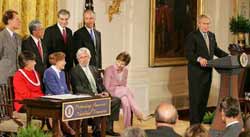
President George W. Bush addresses guests in the East Room of the White House before signing a proclamation to create the Northwestern Hawaiian Islands Marine National Monument. (Photo courtesy of: The White House)
ANDERSON: It was clear during the initial run for the White House that strategists believed that the environment was the Achilles’ Heel, and that if they tried to take Al Gore on with an environmental issue he would impale them on that sword. Gale Norton, myself, and several others tried to make the case that there was a way that you could be a Conservative conservationist, and that way was to abide by fiscal conservatism as well as market-based approaches, and that was the line we pushed. Somehow Republicans still have not gotten that message, despite the fact that there are literally thousands of Republicans who are in that middle of the road who sincerely care about the environment and find it the issue that really bothers them on the Conservative side.
CURWOOD: Terry Anderson is the executive director of the Property and Environmental Research Center in Bozeman, Montana. Thank you sir.
ANDERSON: Thank you, Steve, pleasure to be with you.
Related links:
- U.S. Department of Interior
- Northwestern Hawaiian Islands Marine National Monument
- The Property and Environmental Research Center
[MUSIC - Most Serene Republic “Proposition 61” from ‘Underwater Cinematographer’ (Arts & Crafts - 2005)]
CURWOOD: Coming up: eels as early signs of climate change in New Zealand. Stay tuned to Living on Earth.
[MUSIC - Bob Moses “Blame It On The Egg” from ‘When Elephants Dream of Music’ (Gramavision – 1993)]
Fishy Business

Andrew Rosenberg, University of New Hampshire professor and former Deputy Director of the National Marine Fisheries Service. (Photo courtesy of: University of New Hampshire)
CURWOOD: It’s Living on Earth, I’m Steve Curwood. The population of fish in the coastal waters of the United States is slowly recovering from a disastrous plunge in the late 1980’s. In 1996, the Magnuson-Stevens Act was amended to require the rebuilding of over-fished stocks by regulating and restricting the amount and types of fish that can be caught.
Now, ten years later, a team of scientist has assessed the effects of the law. One of them is Andy Rosenberg , former deputy director of the National Marine Fisheries Service. He now teaches at the University of New Hampshire. Hi, Professor.
ROSENBERG: Hello, Steve.
CURWOOD: Now you recently authored an article that you called “Rebuilding U.S. Fisheries: Progress and Problems.” Just how many fish stocks did you study and, well, how are they doing?
ROSENBERG: Well, we looked at 74 commercially and recreationally important fish stocks. For 67 stocks, the requirements of the law have resulted in rebuilding plans being implemented. And the result was somewhat surprising to me. We found when we looked at the 67 stocks that have been included in rebuilding plans, 45 percent of those stocks are still being over-fished even though they’re under a rebuilding plan. And so one of the questions we have to ask is, So why are we still over-fishing stocks when they’re supposed to be under rebuilding plans?

Andrew Rosenberg, University of New Hampshire professor and former Deputy Director of the National Marine Fisheries Service. (Photo courtesy of: University of New Hampshire)
ROSENBERG: There is tremendous pressure from – and it’s really political pressure in a lot of ways from the fishing industry – to slow down the implementation of any restrictions. Unfortunately that means that, in many cases, instead of actually addressing the problem of over-fishing upfront, we’ve had these very slow phase-in programs that reduce fishing a little bit every year. That can often be detrimental, because it’s not as if the fish want to wait for us to adjust. They’re not terribly concerned with whether, you know, humans are adjusting to changes in the way that they operate their businesses. The stocks continue to decline and we dig a deeper and deeper hole.
CURWOOD: Which species are having the most trouble right now?
ROSENBERG: Well, cod in the Northeast is sort of a poster-child for over-fishing. It’s been a long-term problem; it’s causing incredible adjustment difficulties in the fishing industry. In the Pacific Coast there are serious problems with the so-called rockfish. There’s a lot of species of rockfish, more than 60 species, but there’re a few species that are primarily been commercial and, in part, recreational targets, and they are struggling. They’re very slow-growing, very low-production species, so it takes them a long time to recover. In the Gulf of Mexico, species like red snapper, and some of the snappers and groupers, have been over-fished for a long time.
And it’s really important to note that in all cases the fundamental issue is can you reduce fishing pressure? Sure, there are environmental variations from year to year – that’s important – but fishing pressure is also always important if it’s at a high level. And so unless you address the impacts of fishing you’re really not going to rebuild most resources. It just doesn’t happen.
CURWOOD: Now the Magnuson-Stevens Act, which deals with the management of U.S. fisheries, is up for renewal. There’s a bill that’s passed the Senate, and there’s another in the House. Professor, what kind of legislation do you see as necessary to improve rebuilding programs in the future?
ROSENBERG: Well the Magnuson-Stevens Act is a really good piece of legislation. The revisions that have been made by the Senate, again, I think make some real progress. I think what needs to be included is we need to hold onto the basic framework of the rebuilding requirement, and we need to strengthen it. And we need to strengthen it by ensuring that over-fishing is ended as quickly as possible.
CURWOOD: Andy Rosenberg is a former deputy director of the National Marine Fisheries Service and teaches at the University of New Hampshire. Thank you, Professor.
ROSENBERG: Thank you very much, Steve.
Related links:
- NOAA Annual Fish Assessment
- Rebuilding US Fisheries: Progress and Problems, by Andrew Rosenberg
Cultural Connection
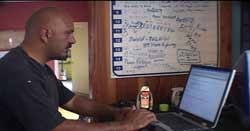
Awanui Black is working on one of the first comprehensive dictionaries in the Maori language. (Photo: Durrell Dawson)
CURWOOD: For millennia indigenous peoples have relied on fishing for subsistence, building up a keen knowledge of how, when and where to catch fish. And this ancient knowledge is giving some modern scientists yet another way to measure the impact of global warming.
As part of our special series, “Early Signs: Reports from a Warming Planet,” we go to New Zealand where the Maori have been fishing for eels for more than a thousand years. Young Maori researchers are now hearing stories from their elders that suggest the traditional eel fishing seasons are changing.
Our series on climate change is a collaboration of the UC-Berkeley Graduate School of Journalism, Salon dot com, and Living on Earth. From New Zealand, Durrell Dawson has our report.
[CHILD’S VOICE; PANTING DOG]
DAWSON: It’s January, the peak of summer in New Zealand, and a frisky white dog darts along a narrow dirt path stretching along the Waitohu Stream in the coastal town of Otaki.
CHILD: Hey, come on.
DAWSON: A group of children are not far behind the dog, as they bound down the path they squeeze past environmental researcher Pataka Moore as he looks down on one of his fishing and eel catching spots.
MOORE: That’s one of our main ones here. Recently we um got about 60 or 70 about a month ago.
DAWSON: He comes here at night to catch the nocturnal long-fin eel, which can grow four feet long. The fish are a good source of protein, and in New Zealand’s indigenous Maori culture they are considered to be taonga – something treasured. Pataka prizes them as an indicator of how well the river is doing – the water’s oxygen level and temperature. He inspects the fish for fungal growth and disease.
MOORE: You can take those eels and look at them and assess them, and they give you a pretty good indication of what the health of the stream is like.
DAWSON: Pataka is also gauging how clean the stream is by interviewing Maori elders almost three times his age about the eel. It’s a hard job. A lot of knowledge has faded since British colonization, and many elders are wary of divulging what’s left. But for a younger generation of Maori, like Pataka, oral histories hold valuable information, like what time of year the eels leave New Zealand’s North Island, or Aotoroa, as Maori named it. Usually, the eel exodus from New Zealand to Tonga marks the end of summer. This year, some of the eel started early.
ROYAL: And it’s not normal.
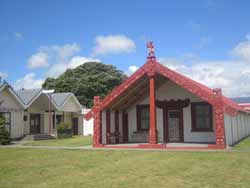
A Maori meeting house, called a Marae, where an assortment of cultural activities take place. (Photo: Alexandra Berzon)
ROYAL: This year, I caught some eels before Christmas that looked like they were heading out to sea. That didn’t happen 30 years ago, 50 years ago, but it’s happening now. March, April is your typical time when your summer was finishing and you’re going into your autumn period, and it’s when you get the first of the autumn rains that the eels would en masse migrate, migrate down the rivers and out to sea. Now, due to our changing weather patterns, we’re getting all sorts of various migrations at all different times.
[CAR NOISE IN BACKGROUND]
MOORE: And that’s unusual, I think, eh? Not only does it mess us up because we don’t know when to fish for the eel or the snapper, but it messes the snapper and the eel up. They don’t know when to run, they don’t know when to send their body through their cycle of maturity and then head to migrate. They don’t know when to do that.
DAWSON: Images of eel have appeared on Maori artifacts and throughout oral histories. But Caleb and Pataka say, according to the oral histories, never has the eel migration been so erratic. Eel migrations correspond with changes in local water temperature and rainfall. But New Zealand’s weather has been increasingly volatile, throwing the eel off.
This past summer was one of the warmest and driest in the Otaki area. But the summer before that, there was a massive flood. New Zealanders are accustomed to extreme differences in a climate where you can get four seasons in a day. But some Maori are saying that lately the seasons are different.
MOORE: These days you just don’t know when a drought is going to come, and when a heavy cold – whether it’s going to be a cold winter or a warmer winter. I suppose it’s those patterns, I don’t know if they’re global or whether they’re just affecting us down here in the South Pacific. But they’re definitely having an effect on our resources and us.
DAWSON: It would be a mistake to think that many Maori still live close to the land. The majority of Maori live in cities far from their tribal areas. With the country’s highest unemployment, lowest numbers of college-graduates, and highest numbers of people with health problems, most Maori aren’t tracking the migration of the eel. But that doesn’t mean they have nothing to lose.
BLACK: My name is Te Awanui Black…
DAWSON: Awanui Black works at Otaki’s Maori university, Te Wananga-o-Raukawa. He specializes in Maori language and culture, and he’s working on one of the first Maori language dictionaries. The environment, he says, is the essence of Maori culture. And he’s concerned about the possible effects of climate change on a people who’ve already weathered colonization and Western influence.

Awanui Black is working on one of the first comprehensive dictionaries in the Maori language. (Photo: Durrell Dawson)

Darren King holds a pohutakawa blossom which is seen by some Maori tribes as an indicator of how long and dry the upcoming summer will be. (Photo: Durrell Dawson)
BLACK: When waiting in battle the weapon is held at this angle, and that’s the path of the rain you see—te areare o te ua. I’m just trying to convey the consistency within Maori culture how one thing relates to the other.
[SOUND OF TUI BIRD]
DAWSON: And it’s because of these connections that science has started to pay more attention.
[FEET CRUNCHING ALONG THE FOREST]
DAWSON: Darren King dodges tree branches as he hikes up a nature trail about an hour northwest of Auckland, New Zealand’s largest city. He once worked as a tour guide here. But now he’s a paleoclimatologist at New Zealand’s National Institute for Water and Atmospheric Research, which has a Maori research and development unit.
KING: For us, Maori environmental knowledge encompasses knowledge that was brought to Aotoroa by the earliest Polynesians, was developed through time over the generations of Maori in Aotoroa, and continued to develop with the arrival of Europeans right through until today.
DAWSON: Darren draws inspiration from his own Maori ancestry. He classifies this project as “for Maori” and “by Maori.”
KING: I get to keep one foot in a camp of paleoclimate, where I’m examining records of isotopes and examining time series of sometimes quite complicated data, and I get to balance that of course with rubbing shoulders with some incredibly generous and incredibly humble and incredibly knowledgeable people who I have links with myself. And that’s an incredibly satisfying thing to do, and I’m very lucky.
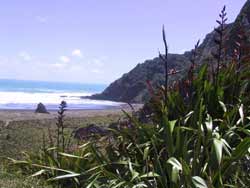
Piha Beach, north of Auckland, is one of many environmental references that permeate throughout Maori oral histories, language, and knowledge. (Photo: Alexandra Berzon)
KING: In terms of some of the more recent observations, it seems that reduced frosts are a very common observation among most, if not all, of the elders that we interviewed. Increasing frequency of storms was another observation that was commonly described by many of the elders, as well as increasing unpredictability and unreliability of local weather.
[ACOUSTIC GUITAR SOUND AND SINGING]
DAWSON: It’s not clear what exactly is happening in New Zealand. Wind, rainfall, and temperature patterns are increasingly variable, which matches the changes predicted by global warming models. But many of these changes don’t have clear scientific explanations and nobody knows for sure if all this is all related to a warming planet. Many Maori aren’t even observing the changes. Some say economic concerns take precedence. But as environmental knowledge becomes more valuable, researchers hope to fill in New Zealand’s climate record with the knowledge of its original residents. For Living on Earth, this is Durrell Dawson.
[ACOUSTIC GUITAR AND SINGING]
CURWOOD: “Early Signs” is a collaboration of the UC-Berkeley Graduate School of Journalism, Salon dot com, and Living on Earth to document places around the world where concerns about climate change are already having an impact. To read a print version of the story about the Maori and see photos - visit our website Living on Earth dot org. That’s Living on Earth dot O-R-G.
Related links:
- National Institute for Water and Atmospheric research
- Maori university in Otaki, Te Wananga-O-Raukawa:
Greening Your Grass the Eco Way
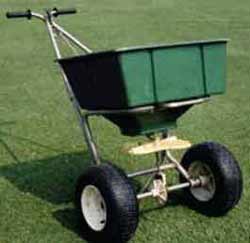
Eco-friendly lawncare requires delicate balance. (Photo courtesy of: Soil & Crop Sciences Department, Texas A&M University)
CURWOOD: It’s estimated Americans spend more than 30 billion dollars a year caring for their lawns. Now that’s a lot of green, much of it spent on things you don’t really need to grow a great lawn. Well, so says Urvashi Rangan. She’s editor of greener choices.org – a service of Consumer Reports – and she says you can grow green grass in a green way and save money. Her first tip: lay off the lawn chemicals.
RANGAN: The number one most environmentally-damaging thing we do through lawn care is the amount of pesticides we put on to lawns. It’s estimated that we use 100 million pounds of pesticides every year in home gardens, and much of that is really on lawns.
And one interesting statistic we came across is the National Academy of Sciences estimated that 50 percent of a person’s lifetime pesticide exposure actually occurred in their first five years of life. And what that says to us is kids who are out there playing on the lawn, pets who are out there playing and then putting hands or paws into mouths, can really up the amount of exposure you have to pesticides.
CURWOOD: But the chemical companies Urvashi say they’re safe.

Eco-friendly lawncare requires delicate balance. (Photo courtesy of: Soil & Crop Sciences Department, Texas A&M University)
You can do some homework yourself by cross-checking the active ingredients in those products with the environmental protection’s cancer list. So, for example, carbaryl, which is a common active ingredient in pesticides, is considered to be a likely human carcinogen. And there’s more than a dozen that are considered by the Environmental Protection Agency to have some probable or possible carcinogenicity.
CURWOOD: This stuff works, though. I mean, people who use these things, their lawns are like perfect, there’s no crabgrass, it’s just absolutely this lush green appearance.
RANGAN: It is true, and, unfortunately, just because your lawn looks green it doesn’t mean it’s clean. And there are other ways, actually, of maintaining a healthy lawn that we can do in a much more sustainable way that isn’t going to be potentially harmful to those who actually play on the lawn.
CURWOOD: So what are the effective natural non-toxic pesticide alternatives?
RANGAN: Well there’s a couple of things people can do. I mean, the first thing to remember is that a healthy lawn is your best defense. So if you keep that lawn healthy, you’re watering it properly, and you’re keeping it fertilized, that’s your number one defense. The second thing you can do is also use some, what we call natural, or biological, controls for your lawn. People may be surprised to know that cornmeal gluten, for example, can be used for weed control like crabgrass in lawns. Ladybugs can be used to control pests. And then there’s other controls, too, like botanical oils, citrus oils, concentrated pepper or garlic juices that can be diluted and sprayed on lawns. All of those have been shown to be effective against pests.
CURWOOD: So I can get rid of those dandelions if I just pour some cornmeal on it?
RANGAN: (Laughs) You know, a lot of it too when we talk about organic techniques is getting out there and picking your dandelions. So physical controls we talk about a lot, too, can also be effective. You don’t always have to hose down your lawn in chemical to get the sort of weed-controlled green lawn.
CURWOOD: Now, come on, wouldn’t the most natural way to take care of a lawn be just, you know, to get some sheep or something? You get fertilizer, you get things cut, and the lawnmowers keep reproducing so you don’t have to go out and buy another one.
RANGAN: (Laughs) I think they have plastic grass now that you can just lay out and, you know, you never need to mow it, you don’t need to do much. Is that more sustainable?
CURWOOD: Urvashi Rangan is editor of greener choices.org, a service of Consumer Reports. Thanks Urvashi.
RANGAN: Thank you, Steve.
Related link:
Greener Choices website
[MUSIC: The Notwist “Consequence” from ‘Semper Satago’ (Domino Recording - 2005)]
CURWOOD: Just ahead: the largest engineering project in history – The U.S. Interstate System reaches its 50 year milestone. Stay tuned to Living on Earth.
ANNOUNCER: Support for NPR comes from NPR stations, and: Kashi, whose “Day of Change” tour features yoga lessons, natural food cooking demos, and Kashi cereals, crackers and granola bars. Details at Kashi dot com; The Kresge Foundation, investing in nonprofits to help them catalyze growth, connect to stakeholders, and challenge greater support. On the web at Kresge dot org; and, The Kellogg Foundation, helping people help themselves by investing in individuals, their families, and their communities. On the web at wkkf dot org. This is NPR, National Public Radio.
[MUSIC: Sex Mob “Sign of the Times” from ‘Din of Iniquity’ (Sony Music – 1998)]
[MUSIC: Nelson Riddle & His Orchestra “The Theme From Route 66” from ‘Ultra Lounge’ (Capitol - 1996).]
The U.S. Interstate System Turns 50
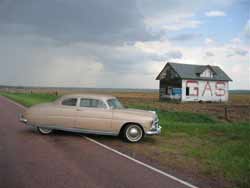
On the 50th Anniversary of the U.S. Interstate, a 1951 Hudson makes a cross-country trip to commemorate the highway system. (Photo: Dan McNichol)
CURWOOD: It's Living on Earth. I'm Steve Curwood. In the year 1956, one out of five homes in America did not yet have a refrigerator. Dear Abby's newspaper advice column made its debut. The soap opera "As the World Turns" had its premiere. And the King of Rock and Roll went gold with a string of hits.
[MUSIC: Elvis Presley “Don’t Be Cruel” from ‘Elvis: 30 #1 Hits’ (1956)]
CURWOOD: 1956 was also the year the U.S. exploded the first airborne hydrogen bomb. Soviet leader Nikita Khrushchev declared "history is on our side…we will bury you." And, on June 29th of 1956, U.S. President Dwight D. Eisenhower signed The National Defense Interstate Highway Act, fulfilling a pledge he had made in a State of the Union Address:
EISENHOWER: A modern highway system is essential to meet the needs of our growing population, our expanding economy, and our national security. We are accelerating our highway improvement program under existing state and federal laws and authorizations. But this effort will not in itself assure our people of an adequate system.
CURWOOD: When he signed the legislation creating the Interstate Highway System 50 years ago, President Eisenhower set in motion the largest public works project in history. There are 55,000 bridges and a hundred tunnels; 42 billion cubic yards of earth were moved to make way for 46,508 miles of interstate roads. And while they comprise less than one percent of the nation’s roads, the interstates accounts for about a quarter of the miles we travel each year.
[MUSIC: Dinah Shore “See The USA in Your Chevrolet” 1957 Radio Advertisement]
CURWOOD: The uniform superhighways, built to strict federal standards, redefined our sense of self and mobility and the relationship between the city and countryside, and paved the way to suburbia.
[MUSIC: Dinah Shore “See The USA in Your Chevrolet” 1957 Radio Advertisement]
CURWOOD: The interstates crisscross America. I-90 is the longest route. It stretches 3,020 miles from Seattle, Washington to Boston, which is not far from Dan McNichol's home in Allston Massachusetts. Dan McNichol is author of "The Roads that Built America – The Incredible Story of the U.S. Interstate System." And to commemorate the 50th anniversary milestone, he took us on a tour of the road in real style.
[TRAFFIC SOUNDS]

On the 50th Anniversary of the U.S. Interstate, a 1951 Hudson makes a cross-country trip to commemorate the highway system. (Photo: Dan McNichol)
CURWOOD: All right. Well, let’s get in then.
McNICHOL: Let’s burn some fuel.
[CAR DOOR OPENS]
CURWOOD: Okay, let’s see here: ohh, hey, this is a big front seat.
[DOOR SLAMS]
McNICHOL: (Laughs) Welcome to my living room.
[CAR STARTS]
McNICHOL: You ready?
CURWOOD: Let’s go. I see a radio. It’s got just AM on it. Does it work?
McNICHOL: It does. Here, I’ll turn it on and see if we get some reception.
[RADIO FREQUENCY]
McNICHOL: It adds to the ambience. You feel like you’re in 1950. If you heard the Red Sox you would expect them to be playing the Brooklyn Dodgers.
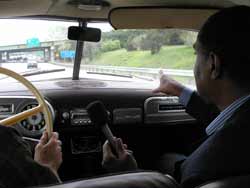
Steve Curwood navigates from the seat of Dan McNichol’s 1951 Hudson. (Photo: Bruce Gellerman)
McNICHOL: When Americans came back from World War II they had money, they wanted to drive fast, they wanted to buy cars. But there were no interstates, no superhighways, except for the Pennsylvania Turnpike. So the states took it on themselves to start building roads. In 1956 there was only 1,500 miles of superhighways here and there around the country.
Eisenhower said this is never going to work, we’re never going to have a national system unless we do it from the top down, like Caesar had done, like Napoleon had done, like Hitler had done. So we launched this project. The whole point, though, is the turnpikes, like the Mass Turnpike we’re driving on right now, were grandfathered into the system in 1956. So instantly, when he signed the legislation, about 2,100 miles of turnpikes around the country became interstate highways.
And the idea was to buy these states out, you know, to pay them off for the roads that they had built and that they were contributing to the interstate system with. That never happened. Congress never acted on that. So the turnpikes, a lot of them, like the Mass Pike, were grandfathered and allowed to keep collecting tolls, even though the rest of the interstate systems, federally-funded, were free highways.
CURWOOD: Okay, so now you got a – oh, now it looks like we’re hittin’ the tolls.
[BEEP]
TOLL BOOTH OPERATOR: Thanks.
McNICHOL: Yeah. Can I get a receipt?
TOLL BOOTH OPERATOR: Sure can.
McNICHOL: Thanks.
TOLL BOOTH OPERATOR: Thank you! Thanks for videoing me! Where’s the video?
McNICHOL: This is radio.
TOLL BOOTH OPERATOR: Yeah, we want some video! (Laughs) I look like Simon Cowell, don’t I?
McNICHOL: (Laughs) See ya.
TOLL BOOTH OPERATOR: See ya!
[MUSIC: Bill Haley & His Comets “See You Later, Alligator” from ‘Fabulous 50’s’ (Madacy Special Recordings – 2005)]]
[MOTORCYCLE, TRAFFIC SOUNDS]
CURWOOD: One thing I noticed about the interstate is there are an awful lot of trucks.
McNICHOL: Yep. You know, the interstate system, I think people had this romantic notion it was about getting in your station wagon, taking the family across country and going on vacation. But it’s really always been about commerce, and more and more so about trucking specifically. The interstate system is about getting inventory to where it needs to go.
Take CVS, for example, a drugstore. They have 41 million miles logged on their trucks on the highways every year, and most of that is on the interstate system. They do 6,100 deliveries, 6,100 different stores, but yet they have a 98.5 percent accuracy on deliveries. And it’s because of the interstate system.
The interstate is the engine of growth. Without the interstate system there would be no internet, there would be no Googling and Amazoning and sending books and sending materials across America by clicking if you didn’t have the interstate system to provide the brick and the mortar deliveries.
CURWOOD: What’s the interstate system done to the environment?
McNICHOL: The interstate system has probably done more to shift the environment, to damage the environment. When you think about going through 46,000 miles of highway, some of them 12 lanes, 16 lanes wide in their extremes, it’s pretty horrendous when you think about the tax that imposes on the earth. The only upside to that is that it allows people to explore areas and hopefully appreciate areas, therefore the environment, therefore preservation and conservation. And by opening up the parks and by opening up the west and by opening up areas of the country people had never been to before, we hope that’s the case.
CURWOOD: How safe is it?
McNICHOL: The interstate system is by far the safest highway anywhere in the world. By a factor of two in this country it is the safest route. If your family’s going across town, if they’re going across the country, you’re twice as likely to survive if you take the interstate system and that’s because everything on it is designed for safety. Everything on the interstate system is designed to keep you alive. Divided highways, the long acceleration and deceleration ramps coming and going off the highway, the wider lanes. There’s 12 feet travel lanes, 10 feet on the right for a breakdown and then three feet on the left to manage a breakdown and repair.
On the side of the road you’ll notice sometimes there are these divots and they’re called Charlie bars. When the car straddles the white line on the right side of the road, it’s meant to wake the driver up because they’re assumingly falling asleep and the idea is to stir them awake before they careen off to the side of the road. And supposedly, the inventor’s son was killed as he was driving home alone. He fell asleep behind the wheel one night. His name was Charlie and as a tribute to him the inventor coined them “Charlie bars.”
T.V. ANNOUNCER: Ladies and gentlemen, James Dean. We probably have a great many young people watching our show tonight, and for their benefit I’d like your opinion about fast driving on the highway. Do you think it’s a good idea?
DEAN: It’s a good point. I used to fly around quite a bit, you know, I took a lot of unnecessary chances on the highway. And I started racing, and now when I drive on the highways I’m extra cautious, because no one knows what they’re doing half the time. You don’t know what this guy’s gonna do or that one. On a track there’re a lot of men who spend a lot of time developing rules and ways of safety. And I find myself being very cautious on the highway. I don’t have the urge to speed on the highway.
[MUSIC: Bo Diddley “Road Runner” from “Bo Diddley: The Chess Box Set’ (Chess – 1990)]
CURWOOD: Today, half a century after construction began, the interstate has transformed our landscape, our lives and our waistlines.
[REST AREA AMBIENCE]
CURWOOD: Chowing down and gassing up have become a daily part of life along America's superhighways. The year before construction began on the interstates, McDonald’s began selling its first of its billions of burgers. But you have to get off the interstate to buy ‘em.
By federal law, eateries and stores are banned from almost all parts of the superhighway system, except for toll roads and some older roads that were grandfathered into the system. The idea was to keep the road commercial-free. So if you’re willing to settle for a just a vending machine, a stretch and a washroom, there are more than 1,200 rest areas serving interstate motorists.
[Door slam]
HOLT: Is that a Hudson Hornet?
McNICHOL:: It’s a Hudson Pacemaker, the economy version of the Hornet.
HOLT: I remember when the Hornet came out.
CURWOOD: Your name, sir, and where you’re from?

Cal Holt, left, reminisces with Steve Curwood and Dan McNichol about the days before the Interstate. (Photo: Bruce Gellerman)
CURWOOD: So do you remember what it was like before the interstate highways?
HOLT: Oh, absolutely. Matter of fact, I had a 1940 Ford, and I drove from Oklahoma old 66 all the way to L.A.
CURWOOD: And what was that like compared to the Interstate now?
HOLT: Well, I tell you what. We went over some mountains when you got out there in Arizona and up through there on the old 66, and there used to be cliffs with about two feet of dirt shoulder, no rails. And you get up there and boy, it was just nothing. You could see cars coming up behind you, right on the windy road going up.
CURWOOD: Uh-huh. If you grabbed the door handle more tightly you won’t fall over.
HOLT: Oh, I tell you! My mother passed out going over. (Laughs)
CURWOOD: But now looking back – you know, this is the 50th anniversary of the interstate system – what do you think it’s done for America?
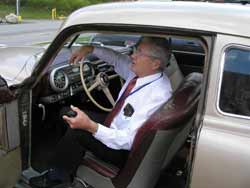
Cal Holt takes a turn at the driver’s seat. (Photo: Bruce Gellerman)
CURWOOD: Why?
HOLT: Because you can drive at high speeds, you can get from here to there. In the old days on these roads it was just, you know, it was just two lanes; 66 was two lanes. One going one way and the other going the other way. No passing zones. Some roads even had the, they called it the “suicide lane.”
CURWOOD: Suicide lane?
HOLT: Yes. It was like three lanes, but the middle lane is cars coming from both directions could pass, you know. And then they had the stripes like you could pull out and pass, and that’s called the suicide lane, because there could be cars coming from both directions.
CURWOOD: Now what’s the worst thing about the interstates?
HOLT: Oh, I don’t find anything wrong with them, except Interstate 90 leaves Logan Airport now. You can get on Interstate 90 and drive to Seattle, but it’s got one stoplight, and that’s in Wallace, Idaho.
CURWOOD: Now why do they have a stoplight in Wallace, Idaho?
HOLT: Because when they put the Interstate in I guess they wouldn’t give theme the right of way unless they could have a stop sign so people could get off in Wallace. It’s a little small town and that was their only income, I guess, was tourists.
CURWOOD: Alright, Cal, well thank you so much.
HOLT: Alright.
[SOUND OF AIRBRAKES RELEASING]
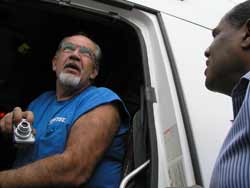
Trucker Jack Wetheral snaps a picture of the vintage auto as he recharges for another coast-to-coast trip. (Photo: Bruce Gellerman)
[TRUCK IDLING]
CURWOOD: Hi there. I saw you taking a picture of the car.
WETHERAL: Yeah.
CURWOOD: Did you used to have one?
WETHERAL: No, but my dad used to have one when I was a kid.
CURWOOD: Oh yeah? Tell me about it.
WETHERAL: Well it wasn’t that color, it was black. But it was a nice car. But that’s a long time ago. I’m 62-years-old, I can’t remember that far back.
CURWOOD: Now this car is just about as old as the Interstate system. In fact, that’s why we’re out here today, it’s the 50th anniversary of the Interstate. You remember what life was like before the Interstates?
WETHERAL: Yeah, I used to drive before the Interstate (Laughs). It was rough. It was rough.
CURWOOD: Yeah?
WETHERAL: But I think it was a whole lot easier than it is today, too.
CURWOOD: Why’s that?
WETHERAL: No traffic.
CURWOOD: Ah.
WETHERAL: This is a 1998 Kenworth T2000.
CURWOOD: Yeah, how much can it haul?
WETHERAL: I can get as much as 34,000 in the trailer and household.
CURWOOD: Yeah? And how far from home are you right now?
WETHERAL: Washington State. Tacoma.
CURWOOD: So you got a long ways to go.
WETHERAL: I gotta deliver one more car tomorrow. Are you from around here? You know who Tom Ashford is? Of the Patriots? I’m loading him next week, taking him out to the Sea Hawks. (Laughs)
CURWOOD: (Laughs) So you’re gonna drive I-90 all the way from Boston to Seattle?
WETHERAL: Mm-hmm, yep. That’s my normal run.
CURWOOD: Now I hear there’s a rumor that when you get to this little town in Idaho there’s a stoplight. Is that true?
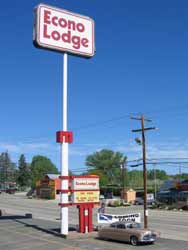
The 1951 Hudson makes a roadside pit-stop along its cross-country journey. (Photo: Dan McNichol)
CURWOOD: Yep. Well, have a great ride on I-90 back to Tacoma, Jack.
WETHERAL: Thank you. Take care now, goodbye.
CURWOOD: So Dan, one of the things about the Interstate, even though we’re riding around in our own little separate castles it somehow seems to bring people together, like at this truck stop.
McNICHOL: You know, the Interstate system probably physically does more to bind the country together than any other structure, any other thing out there. It brings you to your family, it brings you to your place of work, it brings your toothbrush and your toothpaste to your front door. And it’s that, I think, that people often forget, and it’s fun to celebrate that because when you sit down and think about it, you think what would life be like without this Interstate system?
[MUSIC: Doobie Brothers “Rockin’ Down The Highway” from ‘Hot Rods & Custom Classics: Cruisin’ Songs & Highway Hits’ (Rhino – 1999)]
CURWOOD: Dan McNichol is author of “The Roads that Built America: The Incredible Story of the U.S. Interstate System.” To commemorate the 50th Anniversary of the Interstate, Dan drove his ‘51 Hudson across the country. You can see pictures of Dan and classic car on our web site, loe.org.
[MUSIC: Doobie Brothers “Rockin’ Down The Highway” from ‘Hot Rods & Custom Classics: Cruisin’ Songs & Highway Hits’ (Rhino – 1999)]
CURWOOD: And we should note that, technically, the interstate will never be completed. But the last segment that was built was the Big Dig in Boston. Now, that eight-mile system of tunnels under the city cost $14 billion, and that’s nearly twice what it cost to construct I-95 all the way from Houlton, Maine to Miami, Florida.
Related links:
- Federal Highway Administration – Interstate 50th Anniversary
- “The Roads That Built America – The Incredible Story of the U.S. Interstate System” by Dan McNichol
- Dan McNichol’s webpage
[MUSIC: Doobie Brothers “Rockin’ Down The Highway” from ‘Hot Rods & Custom Classics: Cruisin’ Songs & Highway Hits’ (Rhino – 1999)]
CURWOOD: Living on Earth is produced by the World Media Foundation. Our crew includes Ashley Ahearn, Chris Ballman, Eileen Bolinsky, Jennifer Chu, Bruce Gellerman, Ingrid Lobet and Jeff Young - with help from Christopher Bolick, Kelley Cronin, and James Curwood. Our interns are Tobin Hack and Allison Smith. Our technical director is Dennis Foley. Alison Lirish Dean composed our themes. You can find us at LOE dot org. I’m Steve Curwood. Thanks for listening.
ANNOUNCER: Funding for Living on Earth comes from the National Science Foundation, supporting coverage of emerging science; Kashi, whose “Day of Change” tour features yoga lessons, natural food cooking demos, and an array of Kashi products. Details at Kashi dot com. Stonyfield Farm. Organic yogurt, smoothies and milk. Ten percent of profits are donated to efforts that help protect and restore the earth. Details at Stonyfield dot com. Support also comes from NPR member stations, the Ford Foundation, the Wellborn Ecology Fund, and the Saunders Hotel Group of Boston's Lennox and Copley Square Hotels. Serving you and the environment while helping preserve the past and protect the future, 800-225-7676.
ANNOUNCER2: This is NPR, National Public Radio.
Living on Earth wants to hear from you!
Living on Earth
62 Calef Highway, Suite 212
Lee, NH 03861
Telephone: 617-287-4121
E-mail: comments@loe.org
Newsletter [Click here]
Donate to Living on Earth!
Living on Earth is an independent media program and relies entirely on contributions from listeners and institutions supporting public service. Please donate now to preserve an independent environmental voice.
NewsletterLiving on Earth offers a weekly delivery of the show's rundown to your mailbox. Sign up for our newsletter today!
 Sailors For The Sea: Be the change you want to sea.
Sailors For The Sea: Be the change you want to sea.
 The Grantham Foundation for the Protection of the Environment: Committed to protecting and improving the health of the global environment.
The Grantham Foundation for the Protection of the Environment: Committed to protecting and improving the health of the global environment.
 Contribute to Living on Earth and receive, as our gift to you, an archival print of one of Mark Seth Lender's extraordinary wildlife photographs. Follow the link to see Mark's current collection of photographs.
Contribute to Living on Earth and receive, as our gift to you, an archival print of one of Mark Seth Lender's extraordinary wildlife photographs. Follow the link to see Mark's current collection of photographs.
 Buy a signed copy of Mark Seth Lender's book Smeagull the Seagull & support Living on Earth
Buy a signed copy of Mark Seth Lender's book Smeagull the Seagull & support Living on Earth

